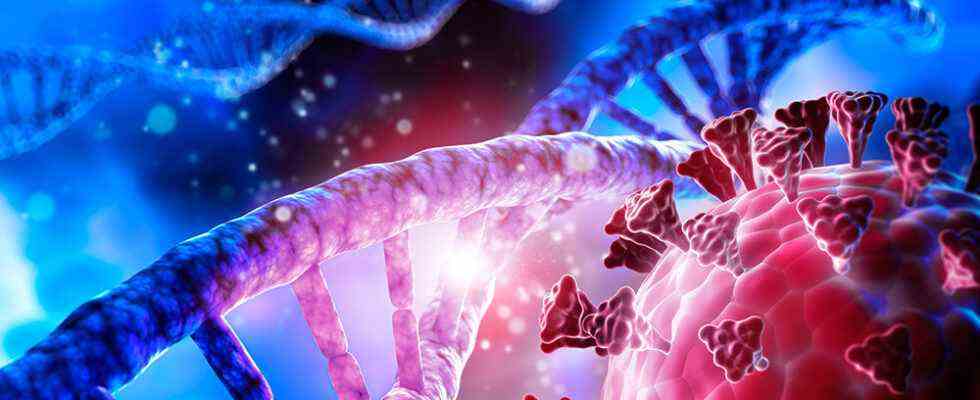Double-edged sword: A gene inherited from Neanderthals increases the risk of a severe course of Covid-19, but at the same time protects against HIV, as a researcher has found. The gene, which occurs in up to 16 percent of Europeans, disrupts the formation of a specific immune receptor and thus prevents the AIDS pathogen from penetrating the cell. It also reduces the risk of smallpox, which may explain why this Neanderthal gene stayed active in our ancestors.
The susceptibility to certain infectious diseases not only depends on the fitness of the immune system, but often also on genetic factors. For example, those who produce fewer of the docking sites that a virus needs to infect the cells make it more difficult for it to multiply. Conversely, gene variants can also promote infections, as is the case with the SARS-CoV-2 coronavirus: A inherited from the Neanderthals Gene section on chromosome 3 increases the risk of severe courses of Covid-19, as a study from the summer of 2021 found.
Why is the Neanderthal sequence so common?
The strange thing is that this Covid risk gene is unusually common in our genome: up to 16 percent of Europeans and 50 percent of people in South Asia carry this Neanderthal gene segment. In addition, the frequency of this DNA sequence increased significantly again 20,000 to 10,000 years ago – long after the Neanderthals had died out.
This begs the question of why this Neanderthal gene piece has persisted for so long and so frequently, and why it is still active today. This is because genes are typically lost if they bring the carrier more disadvantages than advantages. “This Covid-19 risk variant, on the other hand, is so common that I wondered whether it might be good for something,” says study author Hugo Zeberg from the Max Planck Institute for Evolutionary Anthropology in Leipzig. Could this gene variant possibly have protected our ancestors from other infectious diseases?
Neanderthal variant affects immune receptors
The starting point for this consideration is the fact that the Neanderthal sequence is right next to a group of important immune genes. These control the formation of various chemokine receptors that are important for the reaction of cells to messenger substances. At the same time, one of these receptors, CCR5, also serves as a docking point for cell infestation for some pathogens such as HIV and the smallpox virus.
For his study, Zeberg used blood samples from around 30,000 people to examine whether and how the Neanderthal sequences affect the function of these chemokine receptors. The result: carriers of the Neanderthal variant show a reduced number of these docking sites on their cells. In a second analysis, the researcher used the genetic data of 591 HIV-infected people and a good 660,000 controls from three gene databases to determine whether people with this characteristic contract HIV more frequently than others.
27 percent reduced risk of HIV
The result: “Carriers of the Neanderthal allele on chromosome 3 have a 27 percent reduced risk of HIV infection,” reports Zeberg. This means that this gene sequence inherited from Neanderthals has negative consequences for Covid.19 by promoting severe courses. Compared to other diseases such as HIV, however, it has an advantage: it reduces the risk of contracting the disease.
“Having this gene variant can therefore be both good and bad for the carrier: bad if they become infected with SARS-CoV-2; good if there is a risk of HIV infection and there is some protection against this virus,” says Zeberg. However, the AIDS virus only spread to humans in the 20th century. Therefore, the protective effect against it can explain why the Neanderthal sequence has become more common since the last ice age.
Smallpox or as an Ice Age selection factor?
Zeberg therefore suspects that this Neanderthal gene was preserved and spread because it protected against another disease. “However, I can only speculate as to which pathogen exerted this positive selection pressure,” says the scientist. One possible candidate is the smallpox virus, which appeared more than 10,000 years ago. It is also interesting that the Neanderthal variant is most common today where cholera is rampant.
In any case, these results underline that the Neanderthal gene is a double-edged sword: In the last two years of the corona pandemic, it has caused many additional deaths and severe Covid-19 courses. At the same time, however, it could have saved many people from HIV infection over the past 40 years – and our ancestors possibly from smallpox or another serious disease. (Proceedings of the National Academy of Sciences, 2022; doi: 10.1073/pnas.2116435119)
Source: Max Planck Institute for Evolutionary Anthropology

